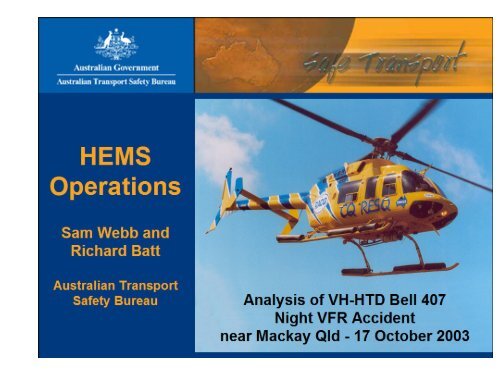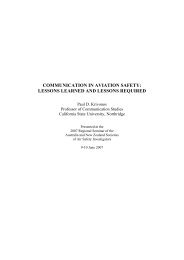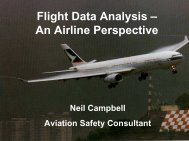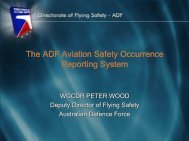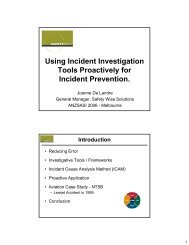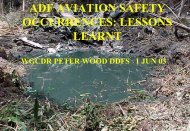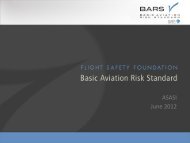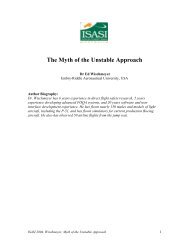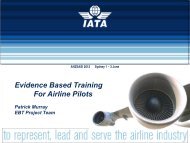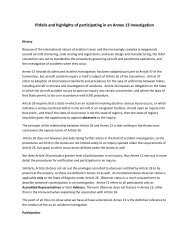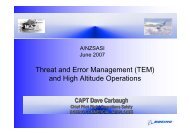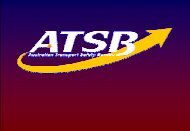Bell 407 Night VFR Accident.pdf - ASASI
Bell 407 Night VFR Accident.pdf - ASASI
Bell 407 Night VFR Accident.pdf - ASASI
You also want an ePaper? Increase the reach of your titles
YUMPU automatically turns print PDFs into web optimized ePapers that Google loves.
Overview<br />
Investigation<br />
Organisational issues<br />
Regulatory issues<br />
11,12 June 2005 NZ<strong>ASASI</strong> Conference<br />
Queenstown
HEMS Tasking<br />
• N<strong>VFR</strong> flight, 3 POB, inter-hospital transfer<br />
Mackay > Hamilton Island > Mackay<br />
• patient was ‘non-critical’<br />
• weather - broken stratus 2-3,000 ft, visibility 7 km,<br />
wind 15 kts from ESE, no celestial lighting<br />
• departed 2132 EST, ETA 2207<br />
• PIC chose 3,000 ft MSL to transit<br />
11,12 June 2005 NZ<strong>ASASI</strong> Conference<br />
Queenstown
History of flight<br />
• at 2217 Mackay advised no arrival<br />
• repeated calls from flight-following<br />
• at 2239 AusSAR advised and BK117 dispatched<br />
• BK117 locates wreckage at 0040<br />
• at 0133 rescue vessel on site - no survivors<br />
11,12 June 2005 NZ<strong>ASASI</strong> Conference<br />
Queenstown
Helicopter Equipment<br />
• <strong>VFR</strong> suite, pop-out floats, Nitesun, RADALT, EPIRB,<br />
winch, GPS, moving map, one AH<br />
• didn’t include - full IFR suite with standby AH, autopilot<br />
or stabilisation system<br />
11,12 June 2005 NZ<strong>ASASI</strong> Conference<br />
Queenstown
Sonar and Salvage
Technical examination<br />
• all components recovered except MR, MRGB, MRBs<br />
upper deck (video analysis)<br />
• reconstruction of the wreckage<br />
• engine, servos, and instrument examination<br />
• analysis of radar data and tower tapes<br />
• download of ECU<br />
11,12 June 2005 NZ<strong>ASASI</strong> Conference<br />
Queenstown
Radar data<br />
8.5<br />
8.4<br />
3,539 P17<br />
3,739<br />
3,439 P19<br />
Distance from radar head- northerly<br />
8.3<br />
8.2<br />
8.1<br />
8<br />
7.9<br />
7.8<br />
7.7<br />
3,439<br />
3,739 P15 3,839<br />
3,739 P13<br />
3,239 2,839 P21 (2144:45)<br />
3,339<br />
3,539 3,439 P11 3,239 P9<br />
3,239<br />
3,139 P7<br />
3,142<br />
3,042 P5 (2143:46)<br />
Altitude in feet AMSL<br />
336° Magnetic<br />
7.6<br />
7.5<br />
36.5 36.6 36.7 36.8 36.9 37 37.1 37.2 37.3 37.4 37.5 37.6 37.7 37.8 37.9 38 38.1 38.2 38.3 38.4 38.5<br />
Distance NM from radar head- easterly
140<br />
120<br />
ECU Parameters<br />
Nr exceedance - trigger for<br />
recording.<br />
%Ng<br />
%Np<br />
%Q<br />
4500<br />
4000<br />
%Nr<br />
100<br />
CP<br />
3500<br />
% (ECU Parameters)<br />
80<br />
60<br />
Derived Pressure<br />
Altitude<br />
3000<br />
2500<br />
2000<br />
Derived Pressure Altitude (feet)<br />
40<br />
1500<br />
12 seconds<br />
20<br />
1000<br />
Start of recording.<br />
0<br />
500<br />
-12 -11 -10 -9 -8 -7 -6 -5 -4 -3 -2 -1 0 1 2 3 4 5 6 7 8 9 10 11 12 13 14<br />
Time from 1st Exceedance (seconds)
Organisational<br />
Issues
Organisational ‘Lite’<br />
Investigation of organisational aspects,<br />
• doesn’t have to be complex<br />
• doesn’t have to be time consuming or expensive<br />
• can achieve something worthwhile<br />
11,12 June 2005 NZ<strong>ASASI</strong> Conference<br />
Queenstown
The circumstances of the accident combined most of<br />
the risk factors known for many years to be associated<br />
with helicopter EMS accidents,<br />
• pilot factors<br />
• operating environment factors<br />
• organisational factors<br />
11,12 June 2005 NZ<strong>ASASI</strong> Conference<br />
Queenstown
Pilot factors<br />
• the pilot had little experience in that type of operation<br />
(ie long distance over water at night)<br />
• the pilot was not instrument rated<br />
• the pilot was new to the organisation and EMS<br />
operations<br />
11,12 June 2005 NZ<strong>ASASI</strong> Conference<br />
Queenstown
Operating environment factors<br />
• dark night with no celestial or ground-based lighting<br />
• the flight path was over water with no fixed surfacelit<br />
features<br />
• marginal VMC<br />
11,12 June 2005 NZ<strong>ASASI</strong> Conference<br />
Queenstown
Organisational factors<br />
• operation from a remote base<br />
• actual or perceived pressures to not reject missions<br />
due to weather or other reasons<br />
• lack of awareness of helicopter EMS safety issues<br />
and helicopter night <strong>VFR</strong> limitations<br />
• divided and diminished oversight for ensuring safety<br />
11,12 June 2005 NZ<strong>ASASI</strong> Conference<br />
Queenstown
Safety oversight<br />
The organisations involved...<br />
• the QLD Department of Emergency Services<br />
Aviation Services Unit operated a helicopter EMS<br />
service (Queensland Rescue)<br />
• CQRESQ was a community advocacy group of<br />
concerned local citizens<br />
• the operator was part of a large worldwide<br />
helicopter operation<br />
11,12 June 2005 NZ<strong>ASASI</strong> Conference<br />
Queenstown
Safety oversight<br />
No single organisation had the ‘big picture’<br />
• Paradoxically, the organisation with the greatest knowledge<br />
and experience had relatively little input, while the<br />
organisation with the least knowledge and experience had<br />
relatively large input.<br />
• Greater safety assurance could have been obtained if one<br />
organisation with knowledge and expertise in aviation had<br />
overall responsibility for operational and safety oversight of<br />
the Mackay helicopter EMS operation.<br />
11,12 June 2005 NZ<strong>ASASI</strong> Conference<br />
Queenstown
Queensland DES - Local safety actions<br />
• strengthened safety standards in service agreements<br />
- CIR requirement, CRM training, Safety Management<br />
System, Safety Officer<br />
• centralised clinical coordination of tasking<br />
(two centres state-wide)<br />
• celestial lighting consideration for N<strong>VFR</strong><br />
11,12 June 2005 NZ<strong>ASASI</strong> Conference<br />
Queenstown
Operator - Local safety actions<br />
• flying staff instruction on N<strong>VFR</strong> operations with<br />
celestial lighting considerations<br />
• all base pilots to have a Command Instrument Rating<br />
• replacement helicopter is IFR equipped<br />
11,12 June 2005 NZ<strong>ASASI</strong> Conference<br />
Queenstown
Regulatory<br />
Issues
Regulatory issues<br />
• CASA requirements and international differences on<br />
categorisation of HEMS<br />
• CASA requirements and ICAO differences on CPL (10<br />
hours instrument, 30 hours for ATPL)<br />
• CASA requirements differences between ATPL<br />
aeroplane and helicopter (CIR)<br />
• limited panel training for N<strong>VFR</strong><br />
11,12 June 2005 NZ<strong>ASASI</strong> Conference<br />
Queenstown
HEMS requirements<br />
JAR OPS 3.005<br />
• two pilots N<strong>VFR</strong>, one for day <strong>VFR</strong><br />
• flight-following<br />
• 1,000 hours PIC (500 rotary) or HEMS co-pilot<br />
• 500 hours HEMS<br />
• 30 minutes helicopter or SIM instrument flying last 6<br />
months<br />
11,12 June 2005 NZ<strong>ASASI</strong> Conference<br />
Queenstown
CASA - Local safety actions<br />
In the pipeline,<br />
• CASR Pt 61 requirement for bi-annual flight review of<br />
N<strong>VFR</strong> rating<br />
• CAAP highlighting HEMS safety issues<br />
• CAAP clarifying N<strong>VFR</strong> safety guidelines<br />
11,12 June 2005 NZ<strong>ASASI</strong> Conference<br />
Queenstown
CASA - Recommendations<br />
For single-pilot night <strong>VFR</strong> helicopter operations, assess<br />
the safety benefits of;<br />
• a standby attitude indicator<br />
• an autopilot or stabilisation system<br />
11,12 June 2005 NZ<strong>ASASI</strong> Conference<br />
Queenstown
CASA - Recommendations<br />
• review the night visual flight requirements and<br />
promulgate relevant information to pilots<br />
• review operator classification and minimum safety<br />
standards for HEMS operations<br />
11,12 June 2005 NZ<strong>ASASI</strong> Conference<br />
Queenstown
Folklore on N<strong>VFR</strong><br />
• remember that the airplane/ helicopter doesn't know that<br />
it's dark.<br />
• there are certain aircraft sounds that can only be heard<br />
at night.<br />
• if you're going to fly at night, it might as well be in the<br />
weather so you can double your exposure to both<br />
hazards.<br />
11,12 June 2005 NZ<strong>ASASI</strong> Conference<br />
Queenstown
US Army review of spatial<br />
disorientation accidents 5/87-4/92<br />
“Of the 583 accidents, 32% had spatial disorientation<br />
as a factor. The cost was 78 lives and $308,887,000<br />
USD. A distinct trend existed between night flying<br />
and spatial disorientation, the maximum risk being<br />
associated with the use of NVGs and FLIR.”<br />
11,12 June 2005 NZ<strong>ASASI</strong> Conference<br />
Queenstown
<strong>Night</strong> <strong>VFR</strong><br />
The definition<br />
relates to the<br />
weather<br />
conditions and<br />
the regs, NOT<br />
to the<br />
techniques<br />
required to<br />
control the<br />
helicopter or<br />
aircraft.<br />
If you have no<br />
visible horizon,<br />
night flight is<br />
instrument<br />
flight and you<br />
are on the<br />
clocks….<br />
11,12 June 2005 NZ<strong>ASASI</strong> Conference<br />
Queenstown


